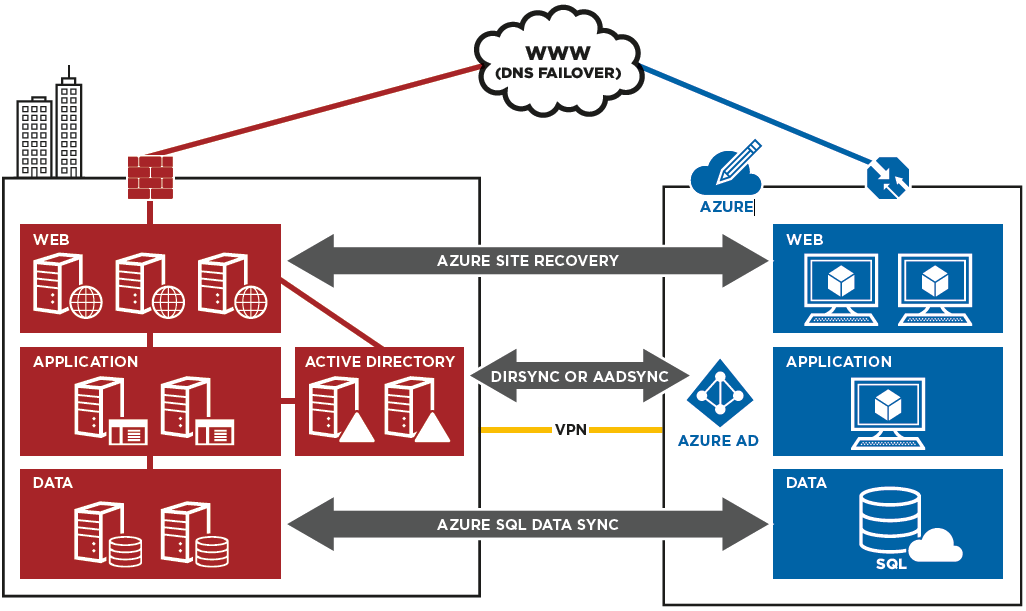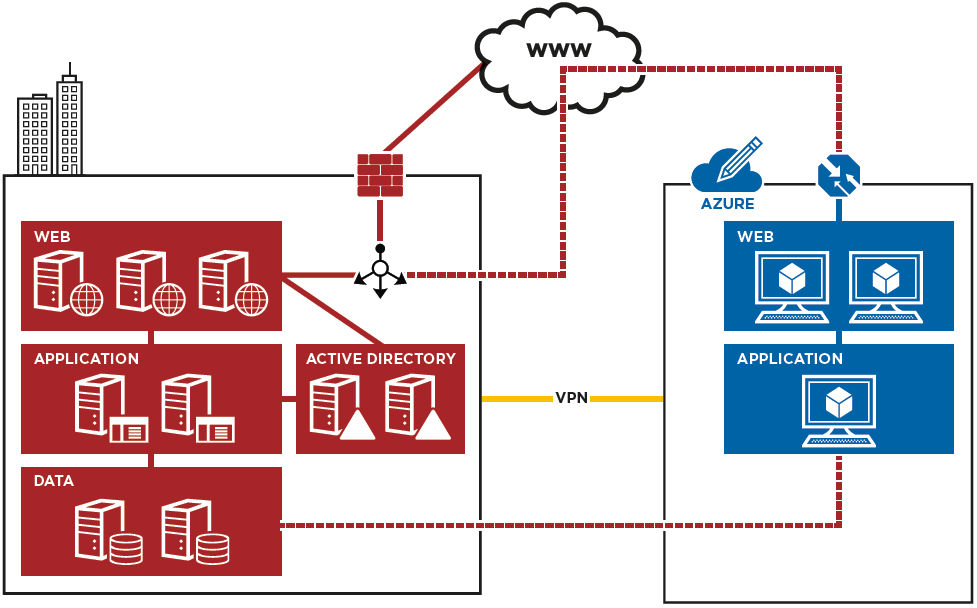The Hybrid Cloud and Microsoft Azure
Introduction
The cloud has become mainstream. Businesses are no longer asking "Should we move to the cloud?" but wondering "When should we move?" and "Where should we locate our cloud resources?" It's that last question of location that often drives the discussion to the concept of hybrid cloud environments.
Hybrid clouds are not new, and some of the foundational elements of hybrid cloud creation, operation and maintenance are rooted in decades-old traditional data center technologies. But much of the thinking around hybrid environments has changed over the years. The types of workloads are much more varied, and the security concerns and needs of even the smallest business have risen to be top of mind. And obviously the technologies have changed – dramatically.
In this paper, we'll examine the concepts of hybrid cloud environments, discuss the potential advantages of using hybrid cloud technologies, and look at how the Microsoft Azure platform enables efficient and effective hybrid cloud computing.
What Is a Hybrid Environment?
BUY, LEASE OR RENT
To help define the term "hybrid environment," it's useful to consider a car analogy. There are basically three choices for acquiring and operating a vehicle: buy, lease or rent.
When you buy a car, you're assuming complete responsibility for it. Financing notwithstanding, it becomes your permanent asset as long as you own it.
Leasing a vehicle is a similar commitment, but with a finite time period attached. You may also have the ability to convert the car into a permanent asset with a purchase option. But the lease is a paid privilege to use the vehicle for your purposes for the duration of the lease.
Renting a car is the most transient option because it's a transaction generally based on immediate need rather than long-term usage. You rent the car by the day or week without any expectation of a commitment beyond the rental period. You probably rent it because your primary automobile is in the shop or because you need some type of functionality or capacity that your primary vehicle doesn't provide (e.g., a truck for hauling).
We can think of computing environments in exactly the same way. On-premises systems (whether physical or virtualized) are usually an ownership-like proposition. Vendorsupplied private clouds, such as the Rackspace Microsoft Private Cloud offering, are essentially leased environments that are solely for your use and dedicated to your needs for the term of the lease. And public clouds offer "rentable" resources that can be acquired and disposed of at will, usually on a bill-by-consumption model.
COMBINING THE APPROACHES
While any one of these approaches might be sufficient for an enterprise's needs, more and more it's becoming necessary to meld private and public resources to achieve a pragmatic balance. Requirements around cost, control, security and timeline can be considered in order to select the right combination. This combination is the hybrid environment.
Considering the car analogy again, it's possible that a family may have one car purchased outright and another that is on a lease. If they need a third car for whatever reason, they may choose to rent another automobile for a short time to address that need. This hybrid approach allows the family to consider factors such as long-term transportation requirements, cash flow, and features or functionality when making the acquisition decision.
The same is true of computing resources for an organization. A given company might need or want on-premises physical or virtualized environments in order to better control access due to security needs. They might also move a portion of those environments to a vendor-supplied private cloud to gain cost advantages, operational efficiencies, or even global reach and scale. And for certain workloads or periods of time, the use of public cloud capabilities may make sense to address transient demands.
How Can a Hybrid Environment Be Used?
There are numerous scenarios in which a business might benefit from a hybrid cloud environment. The most common are:
- Disaster recovery and failover
- Peak load handling
- New business capabilities
Each of these scenarios has specific requirements that dictate how the environments might be set up.
DISASTER RECOVERY AND FAILOVER
Worst-case scenarios do happen. Unfortunately, many businesses are not prepared for them. IT assets around the world remain unprotected and vulnerable to unexpected outages because traditional disaster recovery (DR) solutions have been overly complex and costly to deploy. They've also been a hassle to maintain. All that is changing for companies interested in self-managing their DR plans.
A DR-to-the-cloud deployment that leverages the Microsoft Azure platform is practical and affordable for organizations of all sizes. It helps make the restoration of your business operations possible by replicating both the enterprise application environment and the data hosted by the applications running on-premises. Unlike a backup model — where data must be restored to the original application environment — DR-to-thecloud brings replicated data up at a service provider site. That data then temporarily runs on a replicated application environment at the target site to help ensure complete business continuity until service on-site can be restored.
Technologies such as Azure Site Recovery (ASR) can enable power and flexible DR solutions that span both physical and virtual machines, automating replication and failover to and between on-premises, Rackspace, or Azure data centers. ASR allows you to replicate a variety of workloads including Active Directory, web applications, ERP and CRM solutions, and more. Rackspace engineers will help design the appropriate DR plan based on recovery time objectives (RTO) and recovery point objectives (RPO).
Other technologies include replicating on-premises Active Directory information to Azure Active Directory, replicating SQL Server data to Azure SQL databases, and more.
The following diagram illustrates just one of many possible configurations:

PEAK LOAD HANDLING
Business workloads are often cyclical. Holiday online shopping is an example of seasonal demand that can overwhelm a company's existing infrastructure. And just like disaster recovery and failover, it's often difficult to justify the expense to procure, house and maintain excess capacity infrastructure. Moreover, if the cyclical demand spans geographic regions at different times of the year, the challenge can be even greater.
To address this challenge, organizations can use a hybrid approach. They can create one environment sized and configured for normal business operations (either on-premises or in a private cloud setting) and then utilize public cloud resources like Microsoft's Azure platform for those times when extra capacity is required. The flexibility of on-demand resources in the public cloud makes it easy to scale quickly and cost-effectively when needed.

As this diagram shows, an enterprise can load balance web traffic (for example, in the online shopping example mentioned earlier) to Microsoft Azure when desired. The Azure platform can store web and application server images and create as many instances of those server images as might be needed to handle the load. The process can be automated using several different approaches, and costs are incurred only as the resources are used. Connectivity back to the on-premises environment allows the application data to stay secure while still allowing access to it by the application servers.
While this diagram shows the use of virtualization technology to achieve the desired outcome, Microsoft Azure also supports various Platform-as-a-Service (PaaS) capabilities as well. Web and logic application components, containerization technologies such as Docker running on Ubuntu, and more allow a company to mix and match as desired.
NEW BUSINESS CAPABILITIES
New ideas can propel businesses to new levels of functionality and additional revenue streams. Because most new ideas have some technology component, the ability to execute quickly against those ideas can be hampered by slow resource provisioning or managing technologies not previously in use. Something as simple as creating an externally facing API for customer and vendor usage can be time-consuming and complex.
Due to their sheer scale, public cloud vendors are uniquely positioned to provide technology functions that would be costly to maintain in-house. If the new idea results in a business need that requires specialized technology, such as data analytics or machine learning, utilizing capabilities such as those offered by Microsoft Azure might mean the difference between leading and trailing in the market.
And as with peak load handling scenarios, services like content delivery and media processing for video and audio can be taxing for on-premises systems. Most importantly, if the business idea doesn't pan out, using the public cloud means you can simply dispose of the resources used to test out the idea.
The following diagram shows some of the Microsoft Azure capabilities such as API apps, CDN and machine learning. Note that some of these technologies might require higher levels of connectivity than others between the on-premises and Azure environments.

And if the new ideas involve expanding into geographies not currently served, the global reach and scale of the Microsoft Azure platform makes it far easier and more cost effective to pursue those markets. With multiple data centers around the world, local users are able to connect in their region, and applications and data can enjoy local performance characteristics as well as geographic redundancy when required.
Conclusion
Using a hybrid environment means having more options than before. Options to recover from problems, options to expand capacity, and options to provide new capabilities not previously offered. Hybrid environments are about striking a pragmatic balance between private and public resources in order to provide robust and cost-effective solutions for your business.
For more information, visit https://www.rackspace.com/en-us/microsoft/managed-azure-cloud. Why Rackspace for Microsoft workloads?
Rackspace is the leader in the Gartner Magic Quadrant for Cloud Enabled Managed Hosting, an accolade we received for delivering the world's best service on the world's leading technologies for over 15 years. We have teams of Microsoft Certified Professionals that can help you architect, design, deploy and manage your applications, whether they are on dedicated servers, private clouds, SaaS platforms like Office 365, or even Microsoft Azure itself.
We offer support on a number of technology stacks and applications, including the following:
- Microsoft Azure
- Office 365
- Microsoft Cloud Platform on System Center and Windows Azure Pack
- Microsoft SQL Server
- Microsoft Exchange
- Microsoft Windows Server
- Microsoft SharePoint
- Skype for Business
About Rackspace
Rackspace (NYSE: RAX)is the #1 managed cloud company. Its technical expertise and Fanatical Support® allow companies to tap the power of the cloud without the pain of hiring experts in dozens of complex technologies. Rackspace is also the leader in hybrid cloud, giving each customer the best fit for its unique needs — whether on single- or multi-tenant servers, or a combination of those platforms. Rackspace is the founder of OpenStack®, the open-source operating system for the cloud. Based in San Antonio, Rackspace serves more than 200,000 business customers from data centers on four continents.